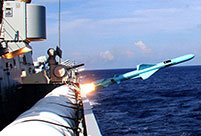

 |
| Photo taken on Jul.29, 2015, shows a piece of debris on Reunion Island. Verification had confirmed that the debris discovered on Reunion Island belongs to missing Malaysian Airlines flight MH370, Malaysian Prime Minister Najib Razak announced early Thursday. (Xinhua/Fabrice Avanande) |
BEIJING, Aug. 7 (Xinhua) -- Five hundred and fifteen days into the largest-scale search mission in human aviation history, the world on Thursday finally got hold of the first solid clue about the grueling mystery of the disappearance of Malaysia Airlines flight MH370.
Following professional analysis at a specialized French laboratory, Malaysian authorities confirmed that the piece of debris found last week near La Reunion Island in the southern Indian Ocean indeed came from the vanished Boeing 777.
For the families of the 239 people on board the ill-fated aircraft, who have gone through 17 months of anguish and distress, the confirmation marked the beginning of a closure which they have prayed could be different.
There is probably still a long way to go before the plane can be located and the enigma unraveled, but China, which has 154 of its people aboard MH370, and the broader international community have never given up hope, and have pledged not to rest until they get to the bottom of the heartrending puzzle.
PAINSTAKING SEARCH
On March 8, 2014, MH370, a red-eye flight, vanished en route from Kuala Lumpur to Beijing, leaving little evidence behind.
China promptly activated the highest level of emergency response and poured a host of personnel and resources into a multinational search and rescue mission that quickly expanded to be the largest ever in human aviation history in terms of both scope and scale.
The search began in South China Sea, where the plane made its last voice contact with air traffic control at 1719 GMT March 7. "All right, good night!" said co-pilot Fariq Abdul Hamid. With more information emerging one piece after another, the focus was gradually shifted and the scope considerably widened.
On March 15, 2014, Malaysian Prime Minister Najib Razak said that the last confirmed signal between the plane and a satellite came at 0011 GMT March 8, and that it turned back and then flew westward back over the Malay Peninsula before turning northwest.
Analysis of satellite communications between the aircraft and Inmarsat's satellite concluded that the plane flew south into the southern Indian Ocean, although the precise location could not be determined.
Then the focus of the rummage shifted to the southern Indian Ocean southwest of the Australian city of Perth, and the searching vessels have been combing that remote patch of water ever since.
CHINA'S INPUT AND RESOLVE
Since the plane vanished, China has not only invested enormous resources into the search, but also served as a mainstay of the demanding mission.
As quickly as one day after the disappearance, Chinese rescue vessels arrived at the search site. As of now, China has dispatched 19 vessels and 13 planes and mobilized 21 satellites to help with the search, including icebreaker Xuelong, which was returning from its scientific mission in the Antarctic.
Chinese President Xi Jinping has pledged on several occasions that the search efforts will continue as long as there is a gleam of hope, despite the immense difficulties.
"We have not forgotten them. We will continue to make all possible efforts to find them," Xi said in his 2015 New Year message.
WRECKAGE FROM LA REUNION
While the search mission forged ahead some 1,800 km off Australia's western coast, a piece of aircraft debris was found on July 29 on a beach of the French island of La Reunion, which is located near the eastern coast of Africa and about 4,000 km away from Perth.
The object has turned out to a flaperon -- a small, lightweight piece attached to the wing -- which aviation experts and oceanographers believe could have stayed afloat while other, heavier pieces of the aircraft had sunk.
A witness reportedly described the piece as "partly encrusted with shells," indicating a long time under water.
The wreckage was transferred to Toulouse, France, where it was examined at a top-notch aviation lab. Malaysia has sent investigators to both La Reunion and Toulouse, while French police are searching La Reunion's coast for more debris.
On Thursday, Malaysia's prime minister announced that the found flaperon was confirmed to be from MH370.
"Today, 515 days since the plane disappeared, it is with a heavy heart that I must tell you that an international team of experts have conclusively confirmed that the aircraft debris found on Reunion Island is indeed from MH370," Najib said.
UNSOLVED MYSTERY, UNFINISHED SEARCH
Finding a piece of the missing plane is far from being enough to unravel one of the most mysterious incidents in human aviation history.
The exact location of the plane's crash remains unknown. A disheartening truth is that finding a flaperon belonging to MH370 might not help locate the aircraft.
The plane has fallen into the ocean and remained there for more than 500 days. The long time span, plus complicated and unpredictable currents of the Indian Ocean, makes recreating the paths of the found wreckage very difficult.
In addition, investigators and the aviation industry are still puzzled by what caused the plane crash, as its black box recorders, whose batteries have already expired, are yet to be retrieved.
Another question is what caused the plane to suddenly divert from its original course.
Najib told the public one week after the flight's disappearance that the deviation was deliberate, but Malaysia Airlines later ruled out the possibility of a pre-planned hijack attempt.
Finding a piece of MH370 wreckage is indeed a major breakthrough, but numerous questions remain to be answered. For the vanished lives, and for the bereft families, the search -- both for the aircraft and for the truth -- continues.
 Female soldiers add color to military parades
Female soldiers add color to military parades Taiwan campus belle with gorgeous look
Taiwan campus belle with gorgeous look  Stunning photos of China’s fighters and airborne troops
Stunning photos of China’s fighters and airborne troops Mums stage breastfeeding flash mob
Mums stage breastfeeding flash mob PLA South China Sea Fleet conducts live fire exercise
PLA South China Sea Fleet conducts live fire exercise Beauty of Tsinghua University transforms into car model
Beauty of Tsinghua University transforms into car model Moscow “spider-man” climbs Chinese skyscraper
Moscow “spider-man” climbs Chinese skyscraper No cleavage allowed at China’s largest gaming expo this year
No cleavage allowed at China’s largest gaming expo this year Photo story: A model’s breast implant surgery
Photo story: A model’s breast implant surgery The trafficked teacher
The trafficked teacher The Uyghurs of China’s ‘Jade City’
The Uyghurs of China’s ‘Jade City’ Japan should recollect cause of Hiroshima
Japan should recollect cause of Hiroshima Photos: Hiroshima and Nagasaki, then and now
Photos: Hiroshima and Nagasaki, then and nowDay|Week